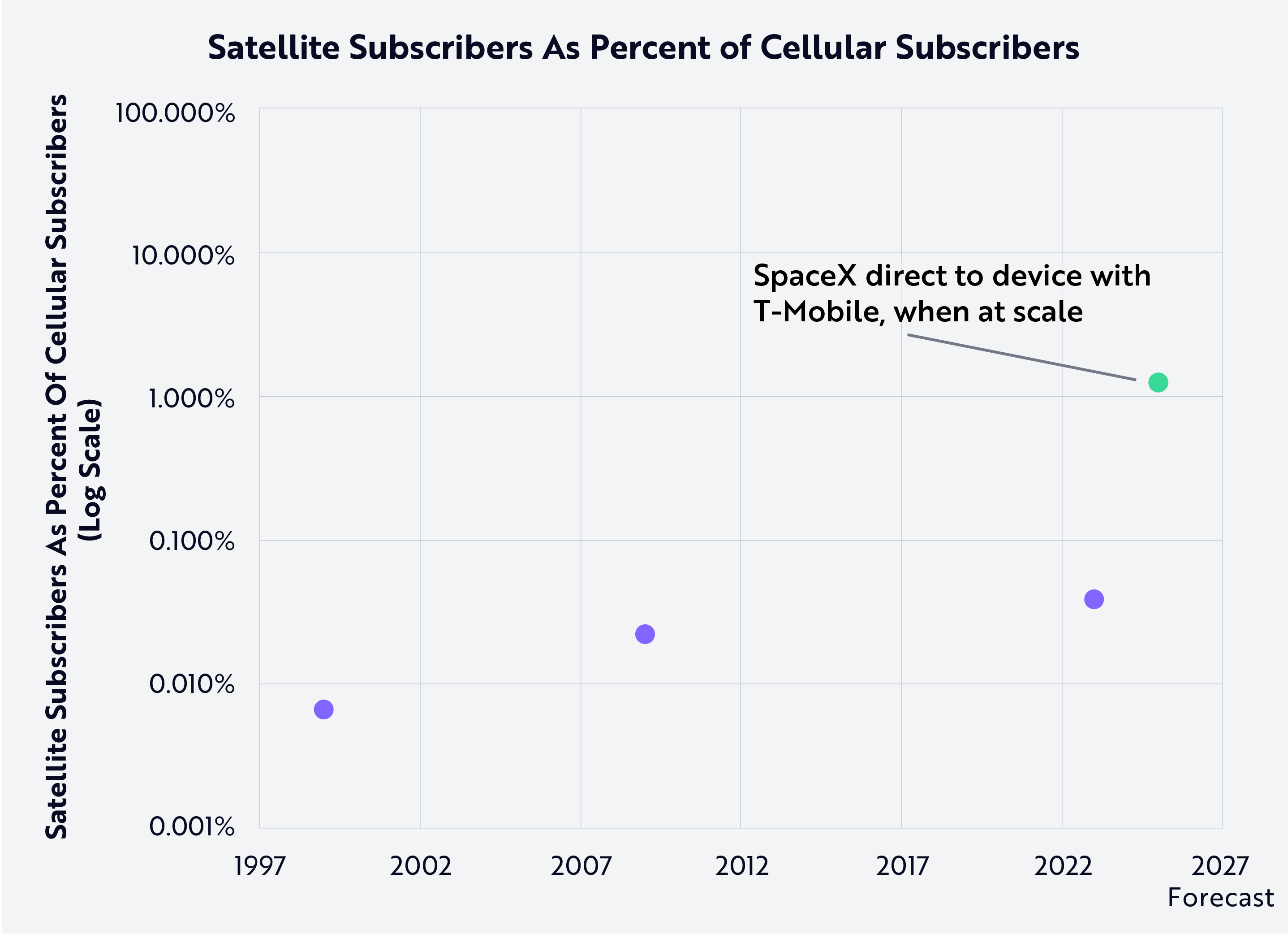#416: Starlink Surpasses Three Million Subscribers As Boeing’s Starliner Hits More Snags, & More
1. Starlink Surpasses Three Million Subscribers As Boeing’s Starliner Hits More Snags


Last week, SpaceX announced that Starlink surpassed ~3 million subscribers,1 as shown on the left below, and showcased its first direct-to-cell video call with T-Mobile on X, the social media platform. SpaceX anticipates rolling out the text-based service later this year, and the voice, data and IoT (Internet of Things)2 services in 2025.
ARK’s research suggests that the partnership between SpaceX and T-Mobile could increase satellite subscribers as a percent of cellular subscribers from ~0.04% today to ~1.25% during the next four to five years, as shown on the right below. Bolstering that trend is AST Space Mobile's recent agreement with AT&T to launch five satellites this summer and offer direct-to-cell service extending to 2030.3 Longer term, our research suggests that direct-to-cell could generate ~$48 billion in annual revenue.4

Source: ARK Investment Management LLC, 2024. These ARK analyses are based on a range of underlying data from external sources as of May 24, 2024, which may be provided upon request. Forecasts are inherently limited and cannot be relied upon. For informational purposes only and should not be considered investment advice or a recommendation to buy, sell, or hold any particular security or cryptocurrency. Past performance is not indicative of future results.
As SpaceX updated investors with this good news, Boeing announced that a helium leak has delayed the launch of its Starliner5 until June 1, 2024. Now ~$1.5 billion over budget,6 the project appears to be falling victim to the “sunk cost” fallacy, especially now that SpaceX's more cost-effective rockets dominate the industry. That said, ARK is awaiting with great anticipation Starliner's upcoming launch and SpaceX Starship’s fourth flight attempt in the coming weeks.7
2. Bipartisan Passage Of FIT21 And The SEC’s Approval Of Ethereum ETFs Mark A Watershed Week

Last week, the U.S. House of Representatives passed FIT21 (Financial Innovation and Technology for the 21st Century) Act, designed to provide the transparency, consumer protection, and legal clarity required to legitimize and grow the digital assets industry on American soil. In the face of well-publicized resistance from the SEC and the current administration,8 FIT21 passed with bipartisan support: 279 votes in favor and 136 against the Act. This surprising win could be the first step toward a comprehensive regulatory framework for the crypto/digital assets industry.
As the House was tallying the votes for FIT 21, the SEC suddenly began engaging with Ethereum ETF issuers, suggesting that some or all the ETFs could be approved this week. Last Monday, the leading prediction market, Polymarket, gave 11% odds that the SEC would approve the Ethereum ETF applications. Things changed abruptly on Tuesday, when the SEC began engaging with the Ethereum ETF issuers on their 19b-4 filings.9 By 5pm EST on Thursday, the SEC had approved eight Ethereum ETFs.10
If FIT 21 makes its way to the US. Senate and Ethereum ETFs begin trading during the next few weeks, the digital assets industry seems poised for some of the greatest legislative breakthroughs to date. In the thick of the election year campaign season, the bipartisan support for digital assets is striking.
3. Drug Discovery Is Evolving From Automation To Autonomy

Automated drug discovery—using robotics, miniaturization, and high-throughput techniques to streamline and scale aspects of the drug discovery process—is reducing manual labor and scaling biological experimentation and data generation at an unprecedented rate. While many drug companies currently use automated techniques, they still rely heavily on human oversight.
Our research suggests that automated drug discovery is a forcing function for autonomous drug discovery. How? The massive scale and throughput of biological experimentation are begging companies to be strategic in choosing their hypotheses. In our view, generative AI agents, or autonomous drug discovery, will take the investigative process to new heights.
Autonomous drug discovery integrates AI agents that manage the entire process, from hypothesizing biological phenomena, to designing and running experiments, to iterating data analysis—with minimal human intervention. The transition could result in significant advantages, including dramatically lower costs per tested hypothesis, reduced cycle times, and higher probabilities of success. It also should spur a leap in productivity that could revolutionize personalized medicine, enabling the broad-based design and development of drugs tailored to individual patients.
While the current state-of-the-art is semi-autonomous, companies like Recursion (RXRX) are pioneering the shift to full autonomy with Recursion OS and the LOWE agent platforms. Those tools use advanced AI to orchestrate complex drug discovery workflows that leverage both wet and dry lab environments. LOWE enables scientists to formulate hypotheses and conduct experiments with a natural language interface, simplifying the process and making sophisticated AI tools accessible to all researchers. As those technologies evolve, they could pave the way to fully autonomous drug discovery, potentially transforming the therapeutic landscape and, as ARK’s research suggests, boosting productivity by 1000-fold or more during the next five to ten years.
-
1
Starlink. 2024. “Starling is connecting more than 3M people…” X.
-
2
Devices with sensors, processing ability, software and other technologies that connect and exchange data with other devices and systems over the Internet or other communications networks. See Wikipedia “Internet of Things.”
-
3
Moon, M. 2024. “AT&T deal will make every phone a satellite phone.” Engadget.
-
4
ARK Investment Management LLC. 2024. “Big Ideas 2024: Disrupting the Norm, Defining the Future.”
-
5
We note here, for readers who may be unfamiliar with products, that Starliner is a space capsule developed by Boeing designed to transport crew and cargo to the International Space Station and other low Earth orbit destinations. Starlink is a satellite internet constellation developed by SpaceX to provide high-speed internet access to underserved and remote areas globally.
-
6
Roulette, J. 2024. “Boeing Targets June 1 For Starliner’s Debut Crew Launch Amid Helium Leak.” Reuters.
-
7
Musk, E. 2024. “Flight 4 in about 10 days.” X.
-
8
Wright, T. 2024. “White House and SEC chair oppose FIT21 bill ahead of House vote.” Coin Telegraph.
-
9
Hayes, A. 2022. “SEC Form 19b-4: What It Is, How It Works, Examples.” Investopedia.
-
10
Although the 19b-4s were approved, the ETFs cannot trade until the S-1 registrations have been approved. The SEC has not yet announced how long that will take.


